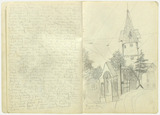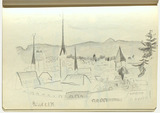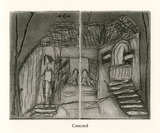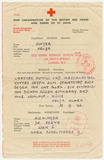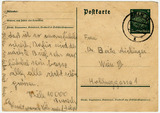Heinz Trökes: Griechische Landschaft [Greek landscape], watercolour (1939)
When Heinz Trökes returned to Germany from a trip to Yugoslavia in 1938, he found his studio completely empty – cleared by the Gestapo. The Nazis vilified his art as “degenerate”.
Heinz Trökes: Grüner Turm von Ravensburg [Green tower of Ravensburg], pencil drawing in the artist’s diary (6 September 1939)
At the beginning of September 1939 the painter Heinz Trökes faced a difficult decision in his Zurich exile. Firstly, he had finally received the post he had been longing for stating that his application for residency in “Dutch India” had been approved! At almost exactly the same time, he received a second piece of correspondence with strict official orders to return to Germany immediately.
Heinz Trökes: Zurich, pencil drawing in the artist’s sketchbook (6 July 1939)
After being forced to leave Germany, Heinz Trökes started to get a feel for Zurich, his new place of residence. He took his sketchbook with him on long walks, filling it with the motifs of his emigration during the summer of 1939.
Heinz Trökes' diary entries from 6 and 18 July 1939 in Zurich, typescript
After being banned from painting and exhibiting by the Nazis, the artist Heinz Trökes was forced in 1939 to go into exile. In the medium term, his plan was to continue further and build up an existence overseas.
Heinz Trökes’ German passport (1937 – 1942)
In the summer of 1939, the painter and textile designer Heinz Trökes left Germany and emigrated to Switzerland. Moving to the city of Zurich was his first step away from harassment by the Nazis, who considered Trökes to be a “degenerate” artist.
Helga Michie: Concord, etching (1979)
Concord was the title given by Helga Michie for her etching depicting a pair of twins looking out of a house window. In view of her own family history and her strong connection to her twin sister, the author Ilse Aichinger, and their separation before the war, it is obvious that the picture is autobiographical in nature.
Helga Michie: Letter to mother and sister (22 September 1942)
The correspondence between Helga Aichinger (now Michie), who escaped to London with the Refugee Children Movement in July 1939, and her family in Vienna is very patchy. In her first few months in England, even after the war started in September, the 17-year-old was able to send long reports home.
Helga Michie: postcard to her family (5 July 1939)
On July 4, 1939, seventeen-year-old Helga Michie (at the time Aichinger) had to leave her family. Her aunt, who had emigrated to England the year before, was able to reserve a place for her on a so-called “Kindertransport” (Childrens Evacuation) train.
Hellmuth Weissenborn: Bombsite London (1941)
Hellmuth Weissenborn was set free from the Hutchinson Camp internment camp on 26 December 1940 and returned to London. The city he returned to lay in ruins, as German forces had started an aerial bombardment on 7 September 1940.
Helmut Krommer: drawing in the guest book of the Constance Home in Guildford (23 November 1939)
A station of exile in England


